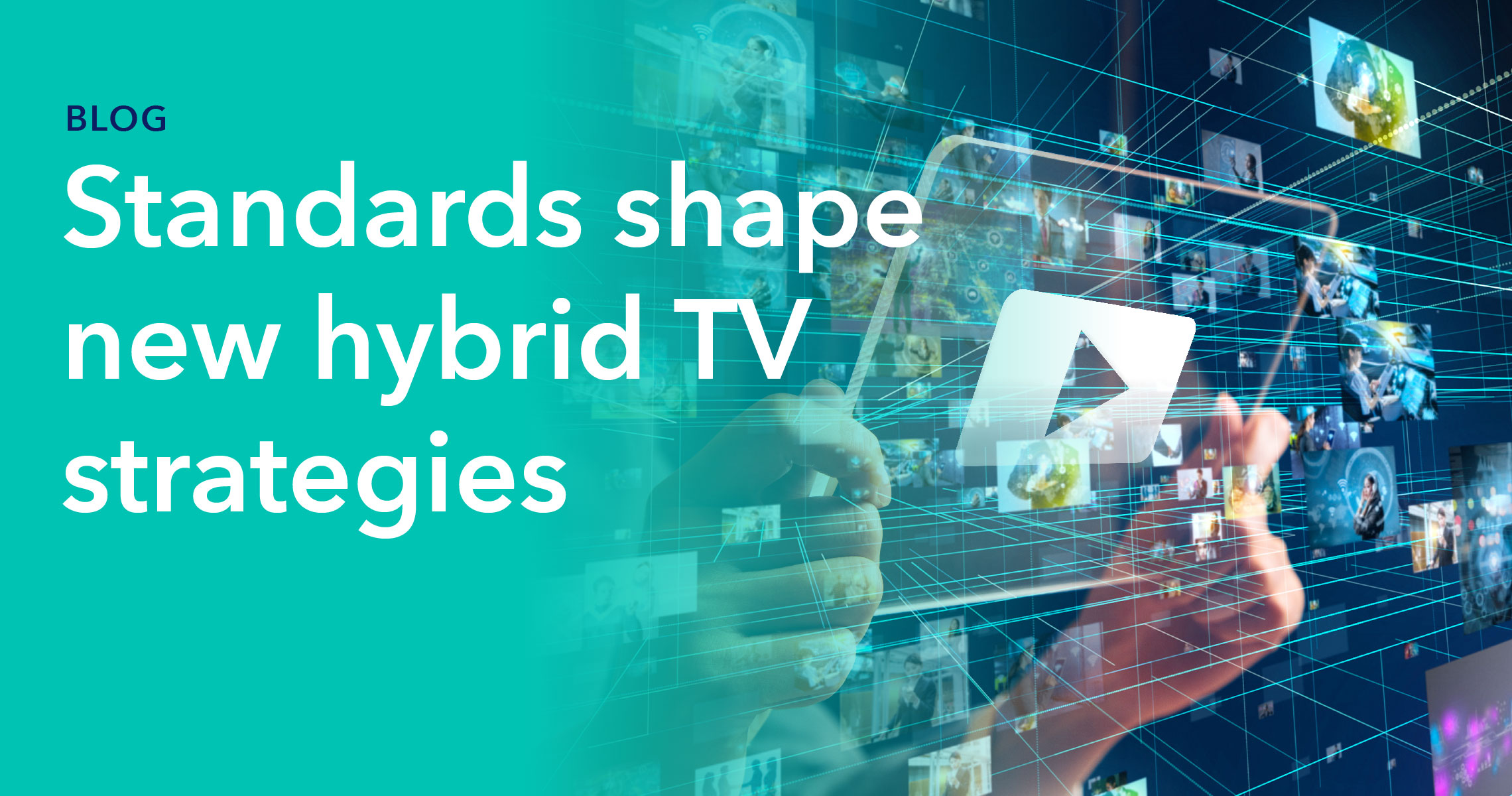- As covered in previous parts of this series, broadcasters are increasingly focused on smart TV penetration and direct-to-TV services.
- The most recent market standards shaping the role of smart TVs in broadcasting are HbbTV, DVB-I, and DVB-TA.
- As these standards become more widely deployed, broadcasting strategies in DVB markets continue its shift toward a hybrid broadcast-OTT approach.
In the last blog of this series, we covered the market forces behind the growing prominence of smart TVs in broadcaster strategies. Today, we’re zooming in on the evolving digital video broadcasting (DVB) market standards and what they mean for DVB broadcasters around the world.
DVB market standards
DVB broadcasters are well positioned to pursue aggressive next-generation hybrid service strategies with all the supply-chain benefits that come with standardized technologies and interfaces. Not only do they have the Hybrid Broadcast Broadband TV (HbbTV) template to work with; they can also look forward to additional benefits emerging with the new DVB-I (Internet) and DVB-TA (Targeted Advertising) standards. Learn more about each standard below.
HbbTV
The HbbTV standard has long supported DVB broadcasters’ ability to leverage opportunities in the internet domain. Now deployed in 37 countries, HbbTV is integrated with most smart TVs sold in DVB markets, enabling delivery of hybrid services without reliance on HbbTV-enhanced STBs.
HbbTV provides a common application execution environment that allows a DVB operator to enrich their program offerings with additional services delivered seamlessly via broadband. Not only does it support access to on-demand and live video streamed over the internet, but it also enables a uniform approach to personalizing OTT service elements and delivering interactive features like game playing and voting.
With the release of a new set of specifications in early 2020, the HbbTV Association has set the stage for a common approach to targeted ad placements on OTT-delivered content. Thus, DVB broadcasters can now deliver a new generation of feature-rich, ad-supported direct-to-TV services that go well beyond broadcasters’ initial use of OTT to simply add a VOD component to their regular broadcast TV services.
DVB-I
The DVB Project’s recent approval of the DVB-I standard has provided additional support to DVB broadcasters’ strategic focus on direct-to-TV and smart TV penetration. DVB-I, prompted in part by regulators’ desire to recapture broadcast spectrum for 5G use, is an open platform that supports delivery of all content in IP mode over broadband and broadcast connections with assurance that broadcast-caliber performance will be maintained with online access.
Specifically, DVB-I supports or enables:
- Delivery of content to connected devices that don’t have broadcast/RF tuners
- DVB adaptations of widely used internet mechanisms supporting low latency and multicast streaming
- Advanced discovery via a uniform approach to cataloguing services in DVB-I Service Lists, enabling connected devices to find sets of linear broadband and legacy TV services
- Insertion of broadcasters’ unique EPG (electronic program guide) data for consumer access on smart TVs and other device interfaces
DVB-I has been closely coordinated with HbbTV under the HbbTV and DVB-I Interoperability group. It operates as a next-gen complement to HbbTV, with a focus on the delivery mechanisms that enable an IP-based hybrid service offering vs. one that retains legacy DVB formatting for one-way broadcast. This enables IP-enabled features like interactive content guides and ad- and content-targeting while retaining support for “lean-back” program selection.
It will be some time before DVB-I is widely deployed, but it will be there to support broadcasters’ full switchover to all-IP services whenever they’re ready. Meanwhile, broadcasters can proceed full steam ahead with the next-gen hybrid services enabled by the latest iterations of HbbTV.
DVB-TA
Another development facilitating broadcasters’ reliance on smart TVs as the linchpin to new service strategies is the DVB Project’s development of DVB-TA specifications and approval for standardization by ETSI.
These specifications adopt the SCTE 104 and 35 signaling mechanisms for triggering DAI (dynamic ad insertion) and indicating the start and end boundaries of placement opportunities for targeted ads. They also set parameters for server-side delivery of targeted ads, or downloads to smart TVs and other devices that would allow client-side DAI with no interference from ad blockers.
A hybrid broadcast standard for the U.S.
In the U.S., broadcasters’ hybrid service strategies are only beginning to take shape following a long period of capabilities testing in response to the ATSC 3.0 standard. But there remains a steep climb to commercial implementation of ATSC 3.0, as it is not backwards compatible with existing ATSC transmitters, off-air receivers, and TV tuners.
The good news is that broadcasters’ commitment to the standard has triggered development of the essential supply chain. After holding back through the early phase of ATSC 3.0 testing, smart TV OEMs have begun to introduce models supporting the new standard.
Like DVB-I, ATSC 3.0 is designed to support IP-based transport for all services. The shift to IP will make the case for eliminating legacy content protection with broadcast services delivered to smart TVs even stronger.
To learn more about the market forces shaping the role of the smart TV in broadcasting strategies, read the full white paper.








